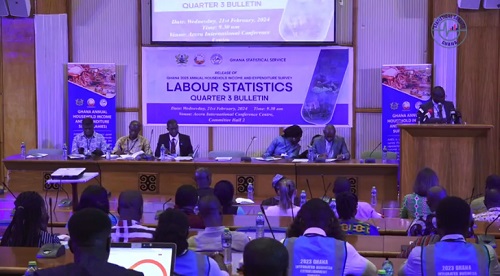The Ghana Statistical Service (GSS) has released its quarterly labour force statistics bulletin for the first three quarters of 2023, revealing crucial insights into the nation's employment landscape.
Among the key findings is the revelation that almost a quarter of individuals experiencing prolonged unemployment spells possess tertiary education qualifications.
According to the report, approximately 22.3 per cent of individuals who faced unemployment spells lasting more than 20 months between the first quarter of 2022 and the third quarter of 2023 had completed tertiary education.
This statistic underscores the challenges faced by educated individuals in securing employment opportunities in Ghana.
Additionally, the bulletin highlights that nearly half (48.8%) of those experiencing extended unemployment spells over the 21-month period held secondary education qualifications. These figures, amounting to 4,565 and 9,987 persons with tertiary and secondary education respectively, underscore the complexities of Ghana's labour market.
In his presentation on the bulletin's highlights, Prof. Samuel Kobina Annim, the Government Statistician said the absorption rate, reflecting the employment-to-population ratio, increased during the observed period.
He added that the number of individuals Not in Employment, Education, or Training (NEET) decreased, and unemployment showed an upward trend. This trend necessitates an evaluation of the readiness of individuals entering the workforce and labour transitions across different economic sectors.
Regional Disparities
Significant variations in unemployment rates were observed across Ghana's administrative regions. While regions such as the Western, Greater Accra, and North East experienced the highest year-on-year increases in unemployment rates, others like the Northern, Savannah, and Bono East regions recorded declines. These disparities underscore the need for tailored interventions to address unemployment challenges, particularly in regions with persistently high rates.
Youth Employment Concerns
Youth aged 15 to 35 years comprised a significant portion (77.4%) of the total unemployed individuals. The report highlights the importance of employment interventions targeting youth, as reflected in the increasing NEET rates observed in recent quarters.
Labour Mobility and Job Creation
The bulletin highlighted labour transitions, emphasizing the need to address exits from employment status and their subsequent re-entries into unemployment. Job creation efforts should consider the challenges posed by recurrent transitions between employment and unemployment statuses.
Utilizing Administrative Data
The report said administrative data can play a crucial role in addressing unemployment spells and labour transitions.
It added that strengthening the use of administrative data sources can enhance policymakers' ability to devise targeted interventions to tackle unemployment challenges effectively.
![]()

